Rajasthan has always been a big draw for tourists, from both within India and abroad. Honour and valour cuts a deep impression in all humans and in India thoughts of same invariably draws one towards Rajasthan. One of the most iconic Bengali films (of the detective genre), Sonar Kella (The golden fort) has many subtle references to the Bengalis’ love for this land and though unstated, I think I have been deeply influenced deeply by these twin concepts.
I had been to Rajasthan couple of times (mainly to Jaipur) for work but I made my first visit as a tourist in 2010 with my parents, who were by then well into their retirement. The fort of Chittorgarh was a “must see” because it epitomizes Rajput and specifically Sisodia spirit of duty and love for the motherland. The many tragic stories of valour and sacrifice associated with it, is another reason. Though I visited the fort twice in two days, it was not sufficient in itself to discover all the landmarks associated with the great history of the fort I had read in “Amar Chitra Katha”.
I always had it in mind to go back to Chittor specifically to see the location of the wall mined by “Akbar” in supervision of the repair of which the commander Jaimal was shot after which there was the last charge of the defenders led by his nephew Patta a stripling of sixteen culminating in the last recorded “Jauhar” at the fort. Then in 2014 the India Tourism advertisements brought to my attention the invincible fort of Kumbhalgarh and its famous defensive perimeter wall. While on a business trip in September 2018, my friend and French colleague, Pierre Yves and I decided on a quick plan to make a trip to Rajasthan to see this iconic fort that had been hidden away and not so well known.
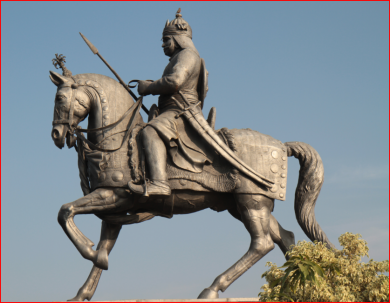
Statue of Maharana Pratap at Haldi-Ghati
Kumbhalgarh is the birthplace of Maharana Pratap, immortalized and a hero of every schoolchild of Bharat, because of his dogged resistance against the most famous of the Mughals – “Akbar” and the battle of Haldi Ghati. History, as is taught in India, records the Rana having lost the battle, though none of the military objectives of Akbar’s army, be it destroying Maharana Pratap’s spirit or capturing Mewar could be realized. The Rana though weakened kept up his resistance with the support of Bhil tribals and by the end of his life regained most of the lands of Mewar though not the capital of Chittor. The fort of Kumbhalgarh around which the Rana fought many battles with Akbar’s forces sent to capture him and torment Mewar, later passed on within his lineage of the Royal House of Udaipur.
For me therefore this was “holy land” which never fell to any Sultan, Mughal or British and therefore a place of pilgrimage and homage, as a land of Ma-Bharati (Mother India) that nursed the flames of independence gave inspiration. It was hard to explain all this to Pierre Yves, but by the end of the trip, the forts and sights conveyed the spirit adequately where my words were inadequate.
The modern-day pilgrimage starts from the lake city of Udaipur. Udaipur is remarkably beautiful as the pictures taken by Pierre Yves show.
The story of Mewar really ends at Udaipur but to start the modern-day tour from this city, is a good idea. The highlight of the city is the City Palace and the “Saheliyon ka bagicha”. However, after seeing these one can plan a trip to Eklingji temple believed to be constructed by the great Rana, Bappa Rawal in 7th century and dedicated to Lord Shiva who is considered the true ruler of Mewar with the Maharana merely his minister. That is also the reason why the connotation Raja or Maharaja is not used by this ruling house. We are lucky that the City Palace is still the personal property of the Maharana as otherwise in government hands it would really be in a sad state of repair.
A cruise in the Lake Pichchola offers some stunning views of the city of Udaipur, City Palace and the surrounding hills.
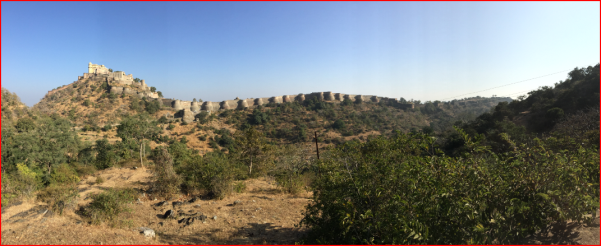
Panoramic view of Kumbhalgarh Fort about 2 km from Fort
Kumbhalgarh is relatively closer to Udaipur than Chittor but still takes between 2 to 3 hours by road. We chose a route that would take us to Kumbhalgarh and on the way back to Udaipur take us through the famous battlefield and pass of Haldi Ghati.

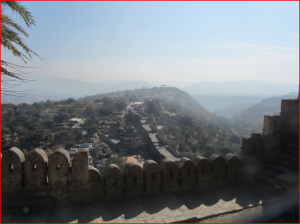
About 4 hours at the fort is adequate to explore the relatively modern palace and the various other sights and abandoned temples in the fort, including a walk on the famous wall of the fort that can accommodate a horse at fall gallop along its entire perimeter that runs for 36 kilometers.
Besides the perimeter wall the unique feature of this fort is the fact that it is so well hidden that it literally comes to view only when one is 2-3 kilometers from the fort. There are several new build hotels around Kumbhalgarh as there is a trekking route through the forests nearby for safari enthusiasts.
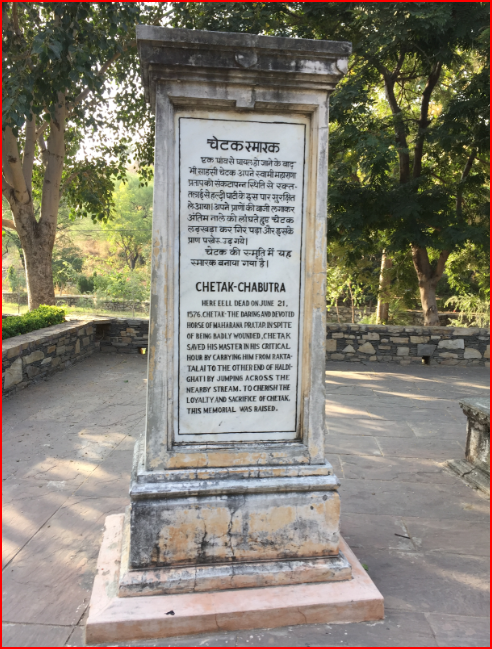 It takes about 2 hours from Kumbhalgarh to Haldi Ghati through some atrocious village roads which makes one wonder what the government has been doing despite promoting this fort as a must see in international advertisements. The actual battle had been fought in an area adjoining the Banas stream or “Banas nullah” at a place referred to as “Rakt Talai”, but as in 2010, I missed this place again and instead we proceeded to Haldi Ghati which is the name of a pass through which Maharana Pratap’s horse Chetak carried him to safety. Today there is a memorial to the Chetak at the spot he died from wounds sustained in the battle. For foreign tourists, the reason for this memorial for Chetak is quite difficult comprehend unless they have been explained in detail about the significance of the Battle of Haldi Ghati. Haldi Ghati is famous for rose petal extracts such as “gulkand” and other flower oils much of which is exported to the Middle East for making perfumes.
It takes about 2 hours from Kumbhalgarh to Haldi Ghati through some atrocious village roads which makes one wonder what the government has been doing despite promoting this fort as a must see in international advertisements. The actual battle had been fought in an area adjoining the Banas stream or “Banas nullah” at a place referred to as “Rakt Talai”, but as in 2010, I missed this place again and instead we proceeded to Haldi Ghati which is the name of a pass through which Maharana Pratap’s horse Chetak carried him to safety. Today there is a memorial to the Chetak at the spot he died from wounds sustained in the battle. For foreign tourists, the reason for this memorial for Chetak is quite difficult comprehend unless they have been explained in detail about the significance of the Battle of Haldi Ghati. Haldi Ghati is famous for rose petal extracts such as “gulkand” and other flower oils much of which is exported to the Middle East for making perfumes.
The next day we travelled to Chittorgarh, again a journey which takes between 2-3 hours, over a relatively better 4 lane highway. The modern town of Chittor is in the back side (or residential side) of the fort. Most of the battles or last charges from the fort were carried out on this side. The present entrance of the fort is also from this side through a motorable road that circles right through the vast fort complex. Chittor is also a living fort where people still live in residences they may not have land deeds for their residences, but which have been passed on from generation to generation amongst people who were in service of the occupiers of the fort, enemies of the Maharana included.
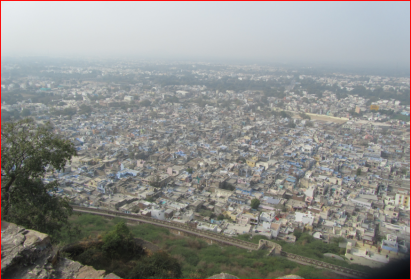
West side of Chittorgarh overlooking modern town of Chittor where most battles were fought
The ruins inside Chittorgarh are a poignant reminder of humiliation, pillage, rape and destruction suffered by Hindu kingdoms whenever they lost in battles to Muslim invaders. The attention to detail in disfiguring Hindu motifs in Rana Kumbha’s Victory Tower and all the other temples in the Fort, by Akbar’s conquering forces after Chittor’s last sack in 1568 is both heart rending and anger rousing. It was an effort focused on pointed humiliation of the Hindu faith and the erstwhile rulers. While there was no structural damage or appropriation of places of worship for mosques (lest it prompt even the collaborators of the house of Man Singh of Jaipur, to rebel!), the depredations were carried out by craftsmen armed with chisel and hammer. A nose or a breast knocked off, petals of the Lotus or The Shiva-Lingam cracked! Despite such baiting the tolerance shown by Maharanas towards their Muslim subjects and indeed soldiers is remarkable.
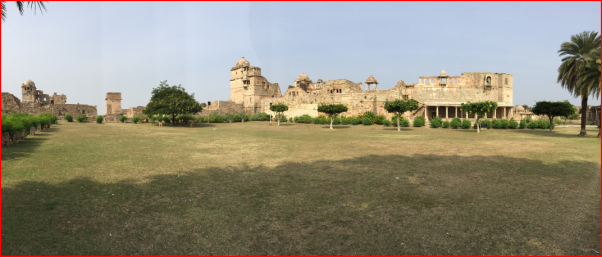
Rana Kumbha Palace inside Chittorgarh Fort

Mahendra-ji, Pierre-Yves and me at Victory Tower
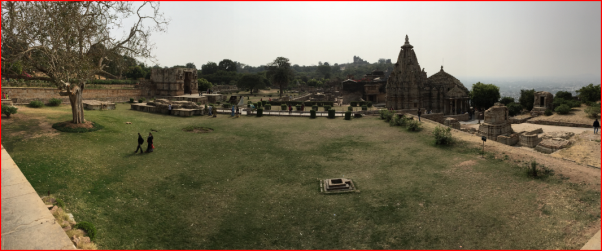
Jauhar Sthal inside Chittorgarh Fort
Sadly, such humiliation of Rajputs by the Indian state has persisted. The latest being claims in the English speaking media that Rani Padmini’s heroic Jauhar was uncalled for, forced by male chauvinism or her character itself being entirely imaginary! Such washing away of history, is derided as “Sickularism” in India, as it is just callous and does more damage to society by depriving the opportunity to draw valuable lessons from causes of ignominious defeats and their repercussions.

Rani Padmini’s garden palace
Sure enough this prompted a discussion between me, our Rajput driver Mahendra-ji and Brahmin guide-Sharma-ji as to whether Brahmins contributed to the last charge led by Patta?
As expected, the answer was that that Brahmins and other castes were not trained in battle! Quite a mysterious topic when Hindu history is full of great warrior teachers such as Parashu-Rama and Dronacharya!
Perhaps this is a topic of research at some foreign university for “sickular” India can never permit such divisive intellectual pursuits!
I again left Chittorgarh with the feeling that the Government Of India needs to re-build selected monuments to convey the glory of the fort, the honour and bravery of Mewar despite defeat. For this I would suggest just 3 areas:
1. The Victory Tower
2. Jaimal’s House of Residence (seemingly now a place for Tantric rites)
3. Meerabai’s house of residence in Kumbha Palace.
I joked to Pierre Yves that as the Mughals had issued a firman that the fort of Chittorgarh should never be rebuilt, perhaps the Government of India was waiting for the Government of Pakistan’s consent (as the successor of the Mughal government) to carry out any such initiative and repairs.
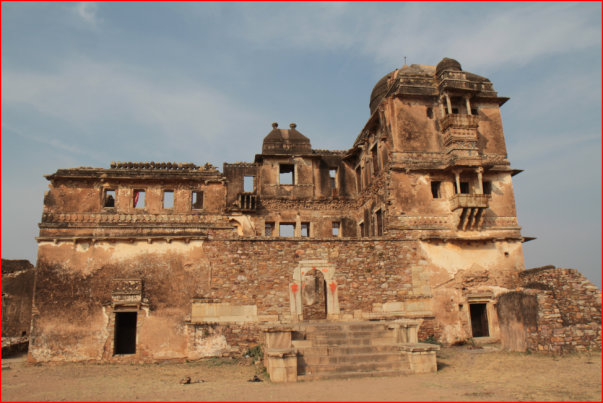
Jaimal Sinh’s palace

Interestingly the Fort of Chittorgarh had been restored to the Maharana of Udaipur in 1868 by the British but even he had not carried out any restoration except build a modern palace inside the Fort. Perhaps for him it was sorrow at the state of his inheritance, but the government of India has no such excuse.
The tour of Chittor nearly comes to an end near the Kirti Stambha near the original main entrance of the fort on the east. It now overlooks farmlands, apparently similar to how it did in history. It was here that sieges were laid and supplies choked off. After the Kirti Stambha, the road reaches the northern edge of the fort where it turns towards the present-day entrance. While exiting, we stopped a last time to pay our respects to the brave Jaimal who had fallen defending the fort.
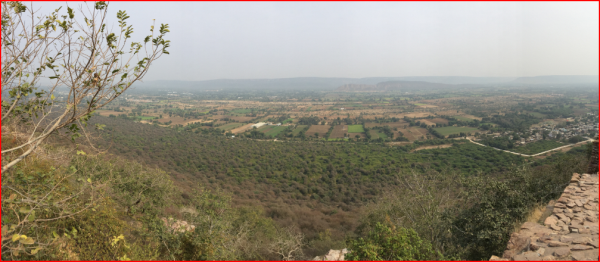
Panoramic view from Eastern Gate of Chittorgarh
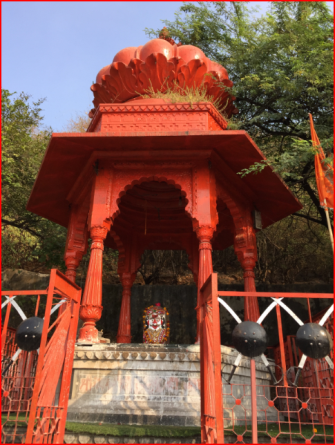
Jaimal Sinh’s Memorial
After Chittor our tour of Mewar was coming to an end. Pierre Yves had enjoyed the trip in the company of a local (me) which he said added more meaning and context to the sights, and perhaps glimpses of India’s tortured history. We made a trip to Mount Abu to see the renowned Dilwara temples. Pictures of the magnificent carvings can only be seen in the internet as public photography is prohibited. However, in one of the last temples that was built, there were no carvings as apparently Bhama Shah had used his wealth in aid of Maharana Pratap’s endeavour’s to resist the Mughals. How I wish that other merchants had done the same!
My pilgrimage to Eternal Mewar, Chittorgarh and Kumbhalgarh was worth it, leaving the desire to do it again. Next time I would go around Kumbhalgarh perimeter, see Rakt Talai and explore the eastern lands around Chittorgarh Fort to understand the nature of the sieges. Perhaps there is a discovery to be made about another great Sisodia ruler.
Details of Trip:
Accomodation : Hotel in Udaipur- Lake Pichchola Hotel
Car Hire: Rajasthan Tours Pvt. Ltd, Udaipur (Virendra.Singh@rajtours.net) (Phone+91 9829042632)
Cost: Total Cost for two excluding Airfare: Rs 70000 over 5 nights and 6 days , including car hire (approx. Rs 17000), hotel accommodation for 2 (Rs 28500), Sumptuous dinners & Beverages, All entry tickets and guides at all locations
#IndianHistory




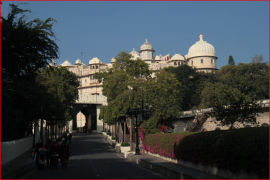

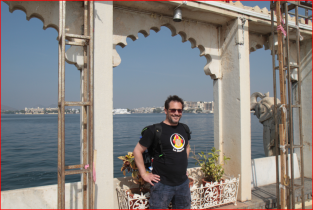

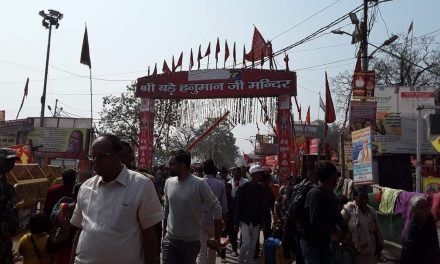
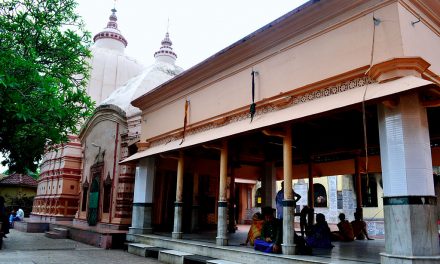












A big thank you for your blog article.Thanks Again. Want more.